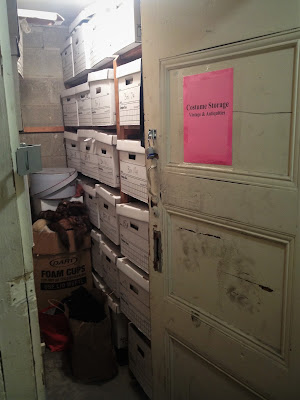 |
| Point Park University Collection - 1860s Sheer Dress |
Project Background
Having expressed great interest in historical clothing, towards the end of my semester at Point Park University, I was given permission and the blessing of all three costume shop professors and professionals to study and photograph some of the extant garments in the university's collection. As a student, this was a HUGE honor to be given the opportunity and their trust to handle all of those priceless extant garments. It was exhilarating. No online collection or behind glass gallery experience could compare to studying the ins and outs of a garment in person. Truly, it was a once in a lifetime experience!
At the Pittsburgh Playhouse, the performing arts center of the university's Conservatory of Performing Arts (COPA), extant garments too fragile (or valuable) for wear on stage are securely stored in the basement. The conditions, however, are not ideal for antique storage. Opening the room for the first time was like Dorothy entering Oz and seeing the world in Technicolor. Though it was hot and stuffy, dusty and definitely had evidence of water damage, all of that was forgotten as I counted over 75 boxes of all shapes and sizes filled with extant garments!
 |
| The antique clothing storage room. |
 |
| In total, I counted 75 boxes and tubs of all shapes and sizes packed with extant garments on the shelves. The overflow was stored in boxes in the hallway. |
 |
| A wall of period shoes, furs and other clothing donations. |
When I asked about the collection, I was deeply saddened to hear that there was not much previous student interest in the extant garments. The conservatory just doesn't have the man power or resources to do much more than box up and store all of those garments. They would really benefit from a service project or two, and someone with curatorial experience to catalog and better store and stabilize such treasures.
For instance, one box that I opened contained six separate, complete ensembles including a beaded Edwardian gown, three-piece silk bustle gown, 1890s suit, black and cream organdy gown, silk day dress, and a two-piece, turn of the century wedding gown complete with matching shoes. Unfortunately, poor storage conditions have caused irreversible damage as most of the garments have terribly shattered silk and mold and mildew spots:
 |
| Before picture of one box containing six entire late-19th and early-20th century ensembles. The garments were sadly exposed to the elements as the box did not have a cover. |
Over the course of several days, I pulled boxes at random, not knowing what I might find inside. Diligently snapping photographs and recording as many notes and measurements as I could, I had hoped to eventually organize a document for future study for Point Park students and myself alike. Though the picture quality is not as clear as I would have liked, since the hallway space was narrow and dimly lit, the idea, inspired by resources like the fabulous blog, All the Pretty Dresses, became to write a series showcasing each of the items I documented.
So, over the next year or two, keep following us and the Extant Garment page for never before seen treasures like the following from the Point Park Collection!
So, over the next year or two, keep following us and the Extant Garment page for never before seen treasures like the following from the Point Park Collection!
1860s Sheer Dress
This is a beautiful, entirely hand-stitched sheer day dress from the Point Park Collection. The overall style and cut of the bodice made me think mid-19th century, specifically the American Civil War Era.
The bodice features a gathers at the front and center backs. Seven functional button holes correspond with seven thread wrapped buttons.
 |
| Close up of thread wrapped buttons. |
Other details include the 1/16" piping at the neckline, armscye and sleeves, and trim carefully applied on the bodice and sleeves. Rather than cuffs, the coat sleeves are trimmed with a 3/4" whitework flounce basted at the wrists.
 |
| Notice the carefully applied trim at the bodice. |
 |
| Sheer, unlined coat sleeves. |
 |
| 1/16" piping at the armscye. |
 |
| Border trim and a 3/4" whitework flounce applied at the wrist. |
The bodice is only lined at the sides and waistband, which features a small pocket perhaps for a watch.
 |
| Lining at the sides and waistband. |
 |
| Close up of extended waistband. Notice the possible watch pocket at the far right. |
The skirt is balanced and gauged to the waistband. It features a 5" self fabric hem and one .5" tuck which hides the seam from piecing extra length. The waistband fastens with two metal hooks and eyes at the center front, and two metal hooks with thread loops on the extension
 |
| Close up of gauging at the waist. |
The fabric, possibly wool or cotton in content, is extremely sheer.
Measurements:
Center Front Length - 52" from the neckline to the front hem.
Center Back - 57"
Waist - 22" when worn on the inner hooks, 26" waistband with extension











What an exciting chance, and thanks for sharing your pictures! Even though there's nothing like seeing things in real-life, such detailed pictures can also be a real treasure!
ReplyDeleteAs they say, a picture is worth a thousand words...especially when it involves historical pretties! ;)
DeleteLove this dress! Saving it to Pinterest....
ReplyDeletePin away! (Just please note that they belong to the Point Park Collection, thanks!)
Delete